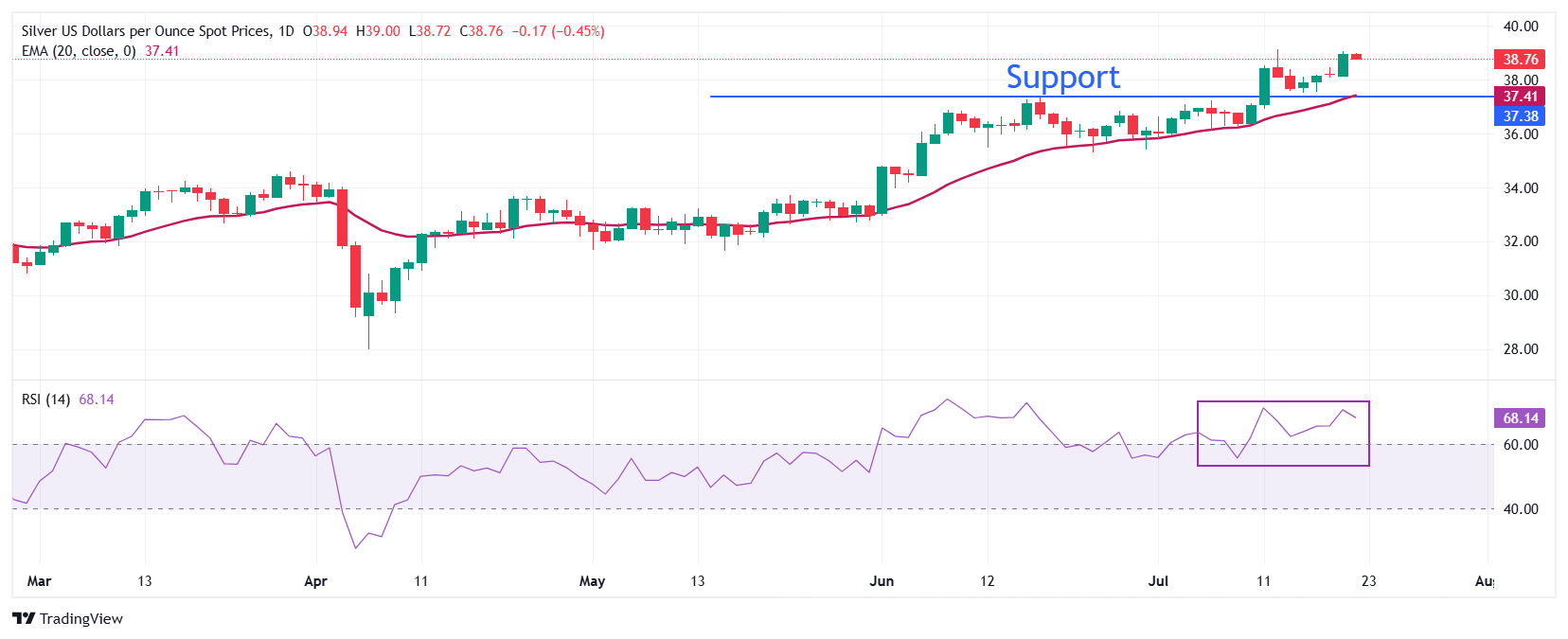Silver Price Forecast: XAG/USD ticks down to near $38.80, stays close to multi-decadal highs
- Silver price falls marginally, but stays close to its multi-decade high near $39.00.
- Trade tensions between the EU and the US have strengthened demand for safe-haven assets.
- The Fed is expected to keep interest rates steady in the monetary policy meeting next week.
Silver price (XAG/USD) edges lower to near $38.80 during the early European session on Tuesday. Still, the white metal is close to its decadal high around $39.00. The outlook of the white metal remains bullish on upbeat demand for safe-haven assets as concerns over global trade flow continue to persist.
Escalating trade tensions between the United States (US) and the European Union (EU) have raised trade tensions across the globe, given the scale of business between both economies. EU officials are preparing for countermeasures to offset the impact of additional tariffs imposed by the US, while struggling to reach a deal.
On Monday, Germany joined its European peers and pressed for a tougher stance on Washington as US President Donald Trump demanded a higher baseline tariff rate for signing a trade deal. “If they want war, they will get war,” Bloomberg reported.
Over the weekend, a report from the Wall Street Journal (WSJ) showed that President Trump is eyeing a higher baseline tariff rate in a range between 15% and 20% against 10% as previously stated. The report also showed that Trump is least interested in waiving 25% tariffs on automobiles.
Theoretically, heightened global trade tensions increase demand for safe-haven assets, such as Silver.
Meanwhile, growing expectations for the Federal Reserve (Fed) to keep interest rates in the current range of 4.25%-4.50% for longer have failed to weigh on the Silver price. Higher interest rates by the Fed for longer bode poorly for non-yielding assets, such as Silver.
Silver technical analysis
Silver price trades broadly stable near its decadal high around $39.00. Upward-sloping 20-day Exponential Moving Average (EMA) near $37.40 suggests that the near-term trend is bullish.
The 14-day Relative Strength Index (RSI) oscillates inside the 60.00-80.00 range, indicating that a bullish momentum is intact.
Looking up, the psychological level of $40.00 will be a key barrier for the Silver price. On the downside, the June 18 high near $37.30 will be a key support zone.
Silver daily chart

Silver FAQs
Silver is a precious metal highly traded among investors. It has been historically used as a store of value and a medium of exchange. Although less popular than Gold, traders may turn to Silver to diversify their investment portfolio, for its intrinsic value or as a potential hedge during high-inflation periods. Investors can buy physical Silver, in coins or in bars, or trade it through vehicles such as Exchange Traded Funds, which track its price on international markets.
Silver prices can move due to a wide range of factors. Geopolitical instability or fears of a deep recession can make Silver price escalate due to its safe-haven status, although to a lesser extent than Gold's. As a yieldless asset, Silver tends to rise with lower interest rates. Its moves also depend on how the US Dollar (USD) behaves as the asset is priced in dollars (XAG/USD). A strong Dollar tends to keep the price of Silver at bay, whereas a weaker Dollar is likely to propel prices up. Other factors such as investment demand, mining supply – Silver is much more abundant than Gold – and recycling rates can also affect prices.
Silver is widely used in industry, particularly in sectors such as electronics or solar energy, as it has one of the highest electric conductivity of all metals – more than Copper and Gold. A surge in demand can increase prices, while a decline tends to lower them. Dynamics in the US, Chinese and Indian economies can also contribute to price swings: for the US and particularly China, their big industrial sectors use Silver in various processes; in India, consumers’ demand for the precious metal for jewellery also plays a key role in setting prices.
Silver prices tend to follow Gold's moves. When Gold prices rise, Silver typically follows suit, as their status as safe-haven assets is similar. The Gold/Silver ratio, which shows the number of ounces of Silver needed to equal the value of one ounce of Gold, may help to determine the relative valuation between both metals. Some investors may consider a high ratio as an indicator that Silver is undervalued, or Gold is overvalued. On the contrary, a low ratio might suggest that Gold is undervalued relative to Silver.

